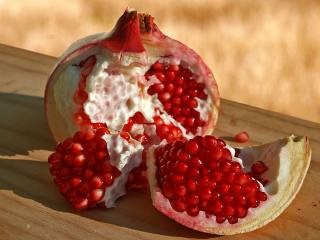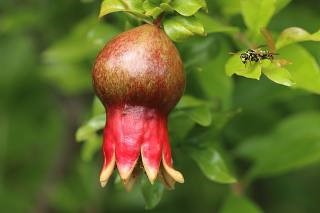Pomegranate
Scientific Name: Punica granatum
Climate: Tropical, subtropical
Plant Description: Shrub or small tree up to 5 m tall. The trunk is straight, with the cracked bark and with opposite branches covered with thorns. Leaves are deciduous, bright green, and flowers are scarlet in color. The end of the flower has a cup-shaped organ called a chalice. The fruit is bright yellow to red in color, and about the size of a large orange. Pomegranates have many seeds that are surrounded by crimson, pink, purple, or white colored covers called arils. The arils are the edible parts of the fruit. They are sweet, juicy and of variable acidity; some varieties can be quite acidic.
Native to the vast region between Iran and India. It has been cultivated in the Mediterranean since ancient times.
Cultivation: It grows in full sun or semi-shade. The best fruits are obtained in places where the period of high temperatures coincides with the ripening time of the pomegranates. The pomegranate adapts well to cold regions. In the middle of winter it resists temperatures below -7ºC.
It is not demanding on soil although it gives better results on deep, alkaline, light, permeable and fresh soils. Very tolerant of drought, salinity, chlorosis and active limestone. But they require frequent watering after planting to establish themselves. Once established, these trees can be watered less frequently and covered with mulch to maintain moisture.
Propagation by seed: This method is not very recommended because the seed will not always be the same as the mother plant. Consequently its fruits can be different. Seeds germinate best at 24-26° C soil temperature. Before sowing the seeds, they must be previously soaked in warm water overnight. Sow inside a greenhouse at a depth of 5 mm with the spaces of 4-6 m between lines, 3-4 m between plants. Water frequently. The seeds will germinate in 45 - 60 days. SIt can be transplanted to the ground when the tree reaches 20-35 cm in height. Prepare the ground for planting, digging deep to aerate the soil and clean the place well. Let dry for 2 days. Fill the hole with compost. Put the plant at approximately the same depth as it was in the nursery. Once the plantation is done, it must be irrigated. Seedlings will flower within a year with substantial bloom over the next year or so.
Propagation by cuttings: Cuttings are cut during the winter (January or February) when the tree is not active. Select straight, curved wood that is free of dormant insects (eggs, scales, insect pupae). One that has no mechanical damage, is mechanically undamaged, diseased, or has lost the bark. The cut for the cutting is done just below a node outbreak. The hardwood cuttings are cut from 25 to 50 cm and are pencil size in diameter. (Hardwood branches are from last year's growth, not new or soft growth.) A different cut is made to mark the bottom (45 degree angle) and the top (90 degree angle). Once gathered, they must be planted in a sunny and well-drained place. Dip them in the rooting hormone and stick them in containers with well-drained potting soil. The cutting is buried vertically in the ground with the latent top bud exposed. In spring, after the cuttings start to grow, transplant them into about 4-liter containers and allow them to continue growing for 4 to 6 weeks before planting them in the ground.
To transplant it to the ground. In order for the tree to produce good fruit, plant pomegranates where they can receive full sun. Prepare the soil by deep cleaning - killing weeds and perennials and siftinh the soil to reduce compaction. You have to fill the hole with a little compost. Plant the cuttings in the ground with only the top half of each protruding. Space plants 360 to 450 cm in rows 450 to 610 cm apart. Don't overload plants because lack of light will reduce growth and production. Keep the soil moist but not wet and wait for the cuttings to show signs of growth. Organic compost or mulch can be used to conserve soil moisture and prevent brush competition. It should be watered immediately after planting and then after 2-4 weeks. And start watering once a week when the leaves of the plants fall off.
After the plant begins to grow, lightly fertilize with nitrogen-containing compost. Use about twice as much compost in the second year and three times as much in the third year.1
Flowering begins in late spring and continues into summer. Under proper conditions, the fruit should ripen 5 to 7 months later. High temperatures are essential during fruit development for a good flavor.
Pomegranates are best grown as shrubs. As the plant begins to grow, choose three to five shoots or trunks, and remove all other shoots. Sprouts should be removed frequently. Once the pomegranate begins to bear fruit, pruning is needed to maintain the main branches, thin the growth and remove dead or damaged shoots. Prune annually.
Trees produce fruits 3-4 years after planting. The fruit matures about 6 months after flowering, with the best fruit development during warm weather. Because the fruit does not ripen after being picked, harvest only after it has reached full maturity. The harvest is done manually, using the scissors with the smallest blade and taking the greatest care, since the fruits are very sensitive to knocks. As the plant matures, it should produce more fruit. Around the fourth year, each tree can produce a harvest of 20 to 25 fruits. In the tenth year, production increases from 100 to 150 fruits.
It is important that during the fattening-harvesting period there are no periods of rain or high humidity.
 Uses: The fruit and seeds are eaten. The fruit contains fiber and vitamins, (including vitamins C and K), nutrients, folate, potassium and is rich in antioxidants. Pomegranates have strong anti-inflammatory properties, which can be helpful in preventing heart disease, cancer (especially in the breasts and prostate), type 2 diabetes, Alzheimer's disease and memory problems with age, possibly treating obesity. These properties can also help with arthritis and joint pain. Drinking pomegranate juice regularly can help lower blood pressure, reducing the risk of heart attack and stroke. Pomegranate has antibacterial and antiviral properties that can be useful against common gum diseases and fungal infections. Pomegranate has been used to treat sore throats, coughs, urinary infections, digestive disorders, skin disorders, arthritis, and to expel tapeworms. The seeds are eaten raw and fresh, in the form of juice or lightly cooked for stews. It can be added to salads. The peel is not edible, but can be made in extract for nutrients.
Uses: The fruit and seeds are eaten. The fruit contains fiber and vitamins, (including vitamins C and K), nutrients, folate, potassium and is rich in antioxidants. Pomegranates have strong anti-inflammatory properties, which can be helpful in preventing heart disease, cancer (especially in the breasts and prostate), type 2 diabetes, Alzheimer's disease and memory problems with age, possibly treating obesity. These properties can also help with arthritis and joint pain. Drinking pomegranate juice regularly can help lower blood pressure, reducing the risk of heart attack and stroke. Pomegranate has antibacterial and antiviral properties that can be useful against common gum diseases and fungal infections. Pomegranate has been used to treat sore throats, coughs, urinary infections, digestive disorders, skin disorders, arthritis, and to expel tapeworms. The seeds are eaten raw and fresh, in the form of juice or lightly cooked for stews. It can be added to salads. The peel is not edible, but can be made in extract for nutrients.
Pests and Diseases: In areas with high humidity, they may be prone to root decay from fungal diseases.
Pests: Aphids. Can be prevented by planting aromatic herbs around trees. Spray the tree with water under pressure; or spray with a mixture of 200 ml of potassium soap in 1 lt of water. Or spray with neem oil.
Llocust bean moth - controlled using natural pheromone traps
Wood leopard moth (Zeuzera pyrina, L.) - It is eliminated by pruning branches with galleries. These branches must be burned to prevent the larva from passing / returning to the tree. Insert cotton reinforced wires into the holes (reliable cotton helically). Finally seal the hole with putty or scar paste.2
Fruit flies - Control by mass trapping or attraction traps with hydrolyzed protein or plant extract.
Fruit rot is the most important disease of pomegranate. It causes pruning of the pulp, it also affects the partitions and membranes, giving the entire interior of the grenade a black color, and the skin that falls into prison penetrates the interior through the pistil. Copper treatments in bloom.3
Phytophthora spp.- affects the vascular system of the plant. It is caused by high humidity. It can be avoided with good drainage.
References:
- https://aggie-horticulture.tamu.edu/fruit-nut/files/2015/04/pomegranates_2015.pdf
- https://www.agroes.es/cultivos-agricultura/cultivos-frutales-y-fruticultura/granado/1112-plagas-del-granado-que-atacan-a-su-cultivo
- https://www.agroes.es/cultivos-agricultura/cultivos-frutales-y-fruticultura/granado/1113-enfermedades-del-granado-que-atacan-a-su-cultivo
En español: Granada

